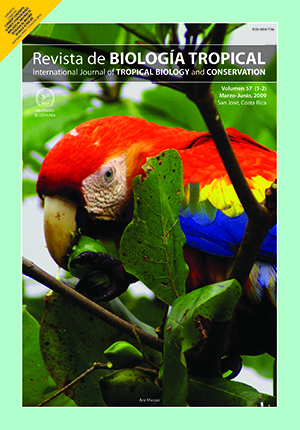Abstract
Seed production, seed dispersal and recruitment are critical processes in population dynamics, because they are almost never completely successful. We recorded the recruitment dynamics for the population of Dipteryx oleifera in a tropical rainforest in eastern Nicaragua (12°05’ N., 83°55’ W.) from March 2002 to August 2006. Seeds and seedlings had highly clumped distributions, while sapling distributions appeared to be random. Seedling survival increased away from the nearest conspecifc adult tree, where seedling density is lower. Since relative growth rates of seedlings are not correlated with the distance to the nearest conspecific adult, seedling survival appears to be independent of seedling growth. Seedling density is inversely correlated with seedling insect herbivory damage. Seedling survival correlated negatively with the number of saplings per sub-plot (10x10m), suggesting that insect herbivore may also cue in on saplings rather than only on adult D. oleifera trees in order to locate seedlings. Seedling establishment is significantly clumped with respect to the nearest adult tree. Larger clumps of seedlings seems more ephemeral than isolated smaller clumps located away from the nearest D. oleifera tree. These results support current empirical evidence presented earlier for the Janzen-Connell hypothesis for Dipteryx oleifera at seed and seedling stages and, the Recruitment Limitation hypothesis at the sapling stage, because sapling individuals might have recruited after random light-gap formation##plugins.facebook.comentarios##

This work is licensed under a Creative Commons Attribution 4.0 International License.
Copyright (c) 2009 Revista de Biología Tropical
Downloads
Download data is not yet available.






